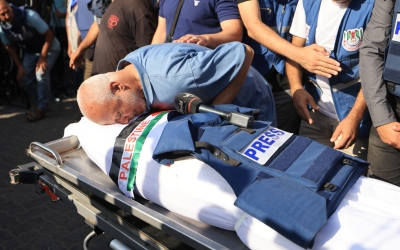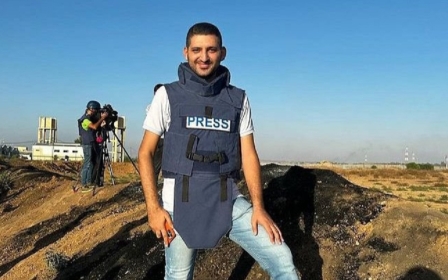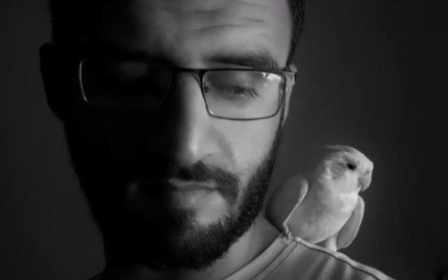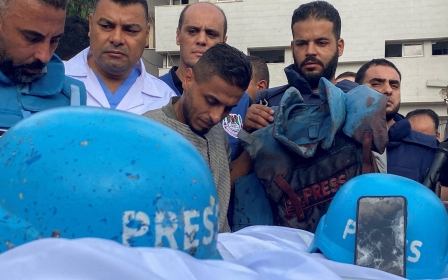Israel-Palestine: Israeli killing of Lebanese journalist 'appears to be war crime'
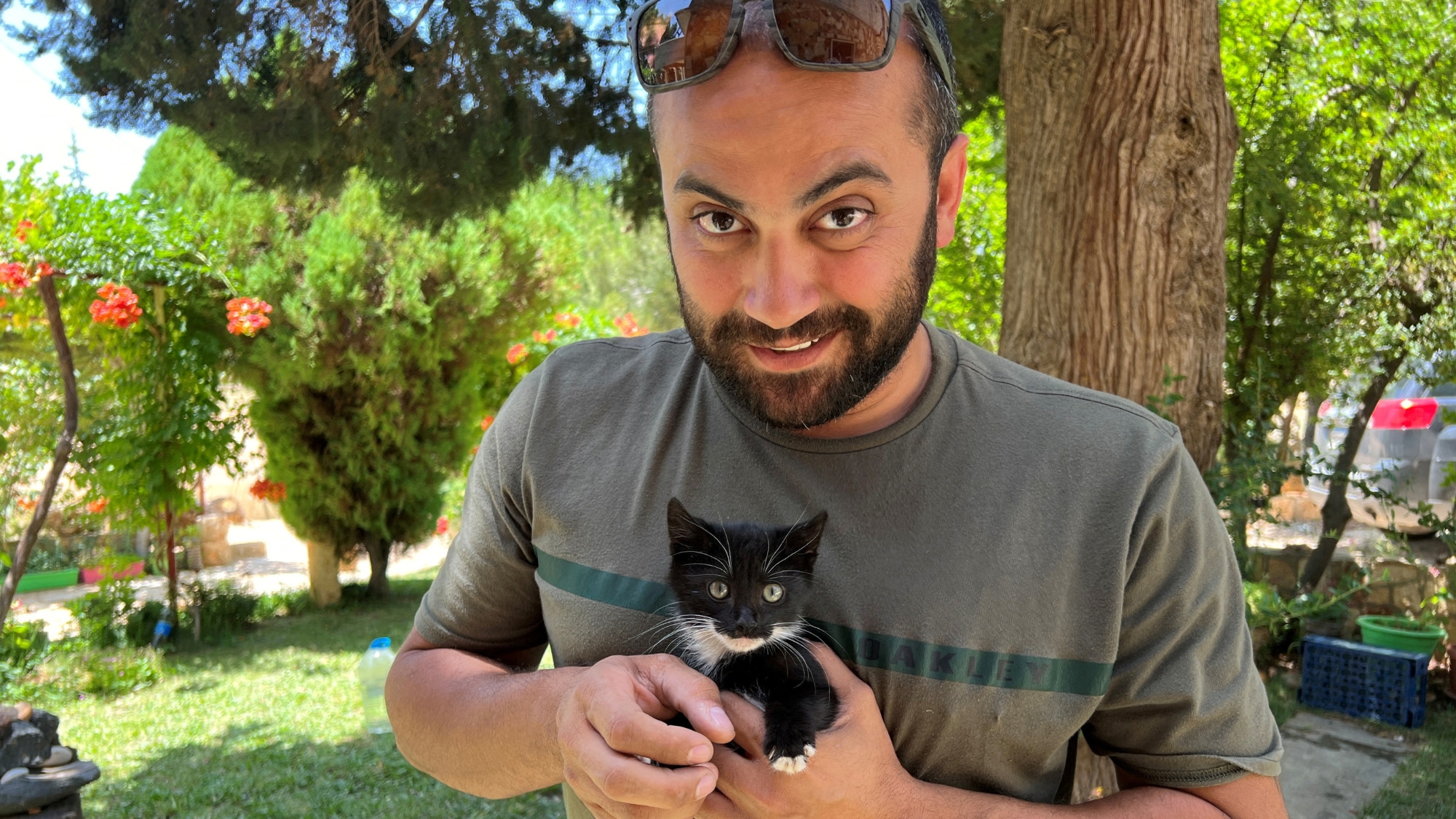
The Israeli military killed a Lebanese journalist earlier this year in what appears to be a war crime, investigations by leading human rights groups have found.
Three reports into the killing of journalist Issam Abdallah on 13 October were published on Thursday by Reuters, Human Rights Watch (HRW) and Amnesty International.
All three found that two Israeli missiles were fired at a group of journalists reporting from south Lebanon near the village of Alma El-Chaab.
The strikes killed Reuters visuals journalist Issam Abdallah, 37, and wounded six other reporters working for Reuters, AFP and Al Jazeera.
Amnesty International said the missiles were "likely a direct attack on civilians that must be investigated as a war crime".
New MEE newsletter: Jerusalem Dispatch
Sign up to get the latest insights and analysis on Israel-Palestine, alongside Turkey Unpacked and other MEE newsletters
HRW said they were "apparently [a] deliberate attack on civilians and thus a war crime".
It added the Israeli military "knew or should have known" they were firing on civilians, based on evidence gathered from seven witness accounts, including three from the wounded journalists, 49 videos, dozens of photos, and satellite images verified by the NGO.
'We condemn Issam's killing. We call on Israel to explain how this could have happened and to hold to account those responsible for his death'
- Alessandra Galloni, Reuters editor-in-chief
Using video evidence, expert audio analysis, and witness accounts, HRW said it appeared the group was visible to the cameras of a nearby unmanned aerial vehicle that was "most likely Israeli".
The group was also “within line of sight of five Israeli surveillance towers, and most likely targeted by at least one munition fired from the main gun of a tank from an Israeli military position approximately 1.5 kilometres south-east” from the Israeli frontier, the report said.
There were two direct hits on the group of journalists that came in the space of 37 seconds. The second strike was likely a small guided missile, Amnesty said.
"We condemn Issam's killing. We call on Israel to explain how this could have happened and to hold to account those responsible for his death," Reuters editor-in-chief Alessandra Galloni said.
"Issam was a brilliant and passionate journalist, who was much loved at Reuters."
When contacted by Reuters, the Israeli military international spokesman Lieutenant Colonel Richard Hecht said: "We don't target journalists."
A helper of stray dogs
Born in the southern Lebanese town of Khiam, Abdallah first began working for Reuters as a freelancer while completing his degree in 2007.
He embarked on an illustrious career covering the 2011 Egyptian uprising, the wars in Iraq and Syria during the fight against the Islamic State, the Russian invasion of Ukraine, and most recently the Turkey earthquake. He was also among the first journalists to report from the site of the Beirut port explosion in 2020, and later received a nomination as a Reuters video journalist for outstanding coverage.
Lama al-Arian, a filmmaker and friend of Abdallah, described him as the "glue that held his colleagues and friends together".
"He always used his journalism to elevate and show the humanity of those suffering," Al-Arian told Middle East Eye.
Growing up during a turbulent period in Lebanese history, Abdallah witnessed Israeli aggression first-hand.
For over 20 years, his hometown of Khiam was under Israeli occupation until the 2000 Israeli withdrawal from southern Lebanon.
The town became known for the notorious Israeli-backed Khiam detention centre, where torture and ill-treatment against detainees were widespread.
'Issam became a journalist because it was a way to shed light on the atrocities happening around him'
- Lama al-Arian, filmmaker
“From conversations I had with him, Issam became a journalist because it was a way to shed light on the atrocities happening around him, while also making the Middle East more understood by people in the West who he felt sometimes misrepresented the region,” al-Arian said.
“Issam also had so much love for animals,” she added of her late friend. “He carried dog food in his car to feed stray dogs on the road. Issam’s best friend, Ahmed, told me the last phone call he received from Issam was Issam saying, ‘Please make sure you take care of my cat. Make sure she’s fed today!’”
Draped in the Lebanese flag, he was buried on 14 October near the olive trees of the town he was born in as hundreds came to pay their respects during the funeral.
In a poignant last display of journalistic solidarity, Abdallah's colleagues laid their cameras on top of his grave.
Targeting of journalists
Abdallah was covering clashes between the Israeli military and the Lebanese group Hezbollah on 13 October near the Israel-Lebanon frontier when he was struck.
Clearly identifiable as members of the media, he and the group of reporters with him had been stationary for around 75 minutes before they were hit by two shell attacks, which eyewitnesses at the scene said came from Israel.
Two other Reuters journalists, Thaer Al-Sudani and Maher Nazeh, two Al-Jazeera TV staffers, Elie Brakhya and reporter Carmen Joukhadar, and Agence France-Press journalists, Christina Assi and Dylan Collins, were wounded in the attack.
HRW said it found no evidence of a military target near their location.
On 14 October, without acknowledging responsibility, an Israeli military spokesperson Hecht, said that they were “very sorry for the journalist’s death” and that they would investigate it.
Reuters' Galloni on 16 October called upon Israeli authorities to conduct a “swift, thorough and transparent probe” into how Abdallah was killed.
“By transparent, I mean an investigation with clear evidence and explanation,” Galloni said in a video statement.
Abdallah’s killing sparked condemnation from the Committee to Protect Journalists (CPJ) and Reporters Without Borders which found that one of the vehicles used by the journalists clearly marked “press” was “explicitly targeted” from the direction of the Israeli side.
Since Israel launched its bombing campaign in Gaza on 7 October, air strikes have killed at least 80 Palestinian journalists in under two months, according to the Palestinian government press office.
"Many journalists in Gaza believe that they are being deliberately and systematically targeted, likewise their families,” said Tim Dawson, the deputy general secretary of the International Federation of Journalists, the world's largest journalists' union, which represents 600,000 media professionals over 140 countries.
Israeli tank fire killed Reuters journalist Issam Abdallah in Lebanon in October. The Reuters journalist was part of a group of well-marked journalists outside an active combat zone. The IDF denies deliberately targeting journalists https://t.co/9Bt5BSA6rT pic.twitter.com/ZEJN0NWdus
— Reuters (@Reuters) December 7, 2023
In correspondence with Reuters, Israeli forces said they cannot guarantee the safety of their journalists working in Gaza.
The first month of the war was the deadliest month for journalists since the CPJ began recording journalist fatalities in 1992.
Since 7 October, Israeli forces have killed over 17,000 Palestinians in Gaza and the West Bank, including at least 7,000 children and 4,800 women.
In Lebanon, Israeli fire has killed 94 people, including at least two children and three journalists.
Palestinian attacks have killed at least 1,200 in Israel in the same period, including over 30 children and 300 women.
Middle East Eye delivers independent and unrivalled coverage and analysis of the Middle East, North Africa and beyond. To learn more about republishing this content and the associated fees, please fill out this form. More about MEE can be found here.



